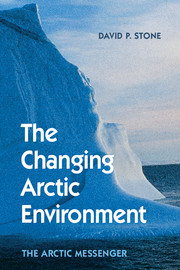Book contents
- Frontmatter
- Dedication
- Contents
- Acknowledgements
- Acronyms
- 1 Personal Beginnings
- PART I THE CHANGING ARCTIC
- PART II WORKING TOGETHER
- PART III WHAT IS THE PRESENT STATE OF KNOWLEDGE?
- 4 Radioactivity
- 5 Heroic Efforts
- 6 Acidification and Arctic Haze
- 7 Stratospheric Ozone Depletion
- 8 Persistent Organic Pollutants and Heavy Metals (Including Mercury)
- 9 Conducting Marine Science in the Arctic
- 10 Climate Change in the Arctic
- PART IV WHAT DOES ALL THIS MEAN?
- Appendix I The Intergovernmental Panel on Climate Change (IPCC)
- Appendix II What Will Happen in the Future If We Do Nothing or If We Try Very Hard to Aggressively Reduce GHG Emissions: Projected Change Under Different Emission Scenarios
- Appendix III Some Geophysical Background Notes Related to Climate and Weather
- Appendix IV Orbital Forcing
- Appendix V The Concept of Commitment
- Bibliography
- Credits
- Index
7 - Stratospheric Ozone Depletion
from PART III - WHAT IS THE PRESENT STATE OF KNOWLEDGE?
Published online by Cambridge University Press: 05 February 2015
- Frontmatter
- Dedication
- Contents
- Acknowledgements
- Acronyms
- 1 Personal Beginnings
- PART I THE CHANGING ARCTIC
- PART II WORKING TOGETHER
- PART III WHAT IS THE PRESENT STATE OF KNOWLEDGE?
- 4 Radioactivity
- 5 Heroic Efforts
- 6 Acidification and Arctic Haze
- 7 Stratospheric Ozone Depletion
- 8 Persistent Organic Pollutants and Heavy Metals (Including Mercury)
- 9 Conducting Marine Science in the Arctic
- 10 Climate Change in the Arctic
- PART IV WHAT DOES ALL THIS MEAN?
- Appendix I The Intergovernmental Panel on Climate Change (IPCC)
- Appendix II What Will Happen in the Future If We Do Nothing or If We Try Very Hard to Aggressively Reduce GHG Emissions: Projected Change Under Different Emission Scenarios
- Appendix III Some Geophysical Background Notes Related to Climate and Weather
- Appendix IV Orbital Forcing
- Appendix V The Concept of Commitment
- Bibliography
- Credits
- Index
Summary
By three methods we may learn wisdom: First by reflection, which is noblest;
Second by imitation, which is easiest;
And third by experience, which is bitterest.
Confucius, The AnalectsWhen scientists in North America, Europe and the Soviet Union were beginning to detect and understand the causes of freshwater and terrestrial acidification, another potentially more serious problem (especially for the Arctic) was slowly being recognized: The stratospheric ozone layer that protects us all from the harmful effects of solar ultraviolet light was thinning.
Before we go further into this part of the Arctic Messenger's story, we need a basic understanding of the behaviour and nature of oxygen and ozone in the stratosphere. Oxygen can exist in three forms. Most commonly, it occurs as a molecule made up of two oxygen atoms (O2). However, it can also occur alone as a single atom (atomic oxygen) or as a molecule of three oxygen atoms (O3). This is ozone. In the stratosphere, highly energetic shortwave ultraviolet radiation from the sun can break O2 molecules apart into lone oxygen atoms. When one of these free oxygen atoms bumps into an intact O2 molecule, it can join up with the molecule to form ozone. However, a cascade of chemical and physical processes involving solar radiation and a number of naturally occurring compounds containing nitrogen, hydrogen and chlorine also continually break down stratospheric ozone. Therefore, the amount of stratospheric ozone present at any moment in time is the result of a dynamic process of production and removal.
Why Is Stratospheric Ozone Important?
Stratospheric ozone absorbs solar ultraviolet radiation (UV), which warms the stratosphere. More importantly, this absorption acts as a sort of filter. The ozone allows only a relatively small proportion of the highly energetic UV radiation to reach the troposphere below.
- Type
- Chapter
- Information
- The Changing Arctic EnvironmentThe Arctic Messenger, pp. 85 - 105Publisher: Cambridge University PressPrint publication year: 2015



